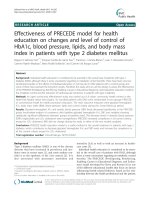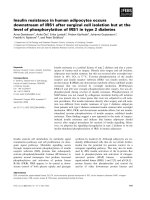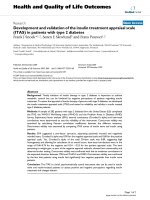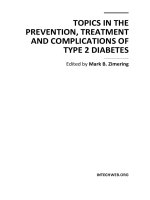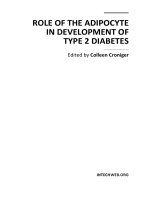management of type 2 diabetes focus on insulin therapy
Bạn đang xem bản rút gọn của tài liệu. Xem và tải ngay bản đầy đủ của tài liệu tại đây (737.63 KB, 45 trang )
Management of Type 2
Diabetes: Focus on Insulin
Therapy
International Diabetes Center
Presentation Overview
• Insulin secretion
– Beta-cell decompensation
• Insulin
– Types of Insulin (Basal and Bolus)
– Action times
– Insulin Analogs
• Insulin Regimens
– Rationale for selecting certain types of insulin
regimens
– Adjusting Insulin
International Diabetes Center
% of
Normal Function
Glucose (mg/dL)
Metformin
Thiazolidinediones
Medical
Nutrition
350
300
250
200
150
100
50
250
200
150
100
50
0
Secretagogue
Post Meal Glucose
Fasting Glucose
(11.1 mmol/L)
(7.0 mmol/L)
Most individuals with type 2
diabetes will eventually
require insulin therapy
Insulin Resistance
Insulin Level
At risk for Diabetes
-10
-5
Beta cell dysfunction
0
5
10
15
20
25
30
Years of Diabetes
Adapted from: UKPDS 33: Lancet 1998; 352, 837-853 DeFronzo RA. Diabetes. 37:667, 1988.
Saltiel J. Diabetes. 45:1661-1669, 1996. Robertson RP. Diabetes. 43:1085, 1994.
Tokuyama Y. Diabetes 44:1447, 1995. Polonsky KS. N Engl J Med 1996;334:777.
International Diabetes Center
Insulin Use in Type 2 Diabetes
• Insulin utilized to overcome both relative insulin
deficiency and insulin resistance
• Purpose of insulin regimen is to mimic normal insulin
secretion patterns
• Approximately 40-50% of patients will require insulin
for glycemic control
• Start dose conservatively and adjust dose based on
patterns of BG
– High dose insulin (>1.0 U/kg) often required to
overcome insulin resistance
International Diabetes Center
Insulin Processing
PC2 Endopeptidase
A-chain
C-peptide
Proinsulin
B-chain
Mature
Insulin
S
PC3 Endopeptidase
S
1
21
S
S
1
S
S
+
C-peptide
30
Insulin supplied in vial or cartridge
DiMarchi et al., Peptides-Chemistry and Biology 1992:26-28.
Howey et al., Diabetes 1994;43:396-402.
International Diabetes Center
Overcoming Insulin Resistance
Insulin
Glucose
G
G G
G GG
G G
G G
G
G
Nucleus
G
Insulin
Receptor
Glucose
Transporter
(GLUT4)
Insulin Sensitive Cell
(Muscle or Fat)
International Diabetes Center
Normal Insulin Secretion
Serum insulin (mU/L)
Meal
Meal
Meal
50
40
Bolus insulin needs
30
20
10
Basal Insulin Needs
0
0
2
4
6
8
10
12
14
16
18
20
22
24
Time (Hours)
International Diabetes Center
Insulins
Types
Examples
Bolus (Meal) Insulin
Rapid-acting
Short-acting
Insulin lispro, Insulin aspart
Regular
Basal (Background) Insulin
Intermediate-acting
Long-acting
NPH, Lente
Glargine
Pre-Mixed Insulin
NPH/Regular
NPL/Lispro
NPA/Aspart
70/30, 50/50
Mix 75/25
Mix 70/30
International Diabetes Center
Bolus/Pre-meal Insulin
Type of Insulin
Rapid-acting
Onset
Peak
Monitor effect at:
5-15 mins
1-2 hrs
2 hrs
30-45 mins
2-3 hrs
4 hrs
(Lispro, Aspart)
Regular
International Diabetes Center
Advantages of Rapid Acting
Insulin Analogs
• Modification of human insulin
– Increased rate of subcutaneous absorption
(more physiological)
• Reduced rates of hypoglycemia
• Convenience - increased flexibility
– Taken with meal (onset of action ~ 10 minutes)
– Reduced risk of exercise-induced hypoglycemia
– Limits need for snacks
– Can be used to cover snacks
International Diabetes Center
Basis of Insulin Selection
Short-Acting Vs. Rapid-Acting
Regular insulin best for
patients who:
1. Generally consume
between meal snacks
2. Eat inconsistently
throughout the day
(“grazers”)
3. Who delay start of meal
after insulin injection
Rapid Acting insulin best
for patients who:
1. Desire increased
flexibility or who vary
CHO intake
2. Don’t desire consistent
snack
3. Have either routine or
sporadic exercise
4. Desire injection
immediately pre-meal
International Diabetes Center
S
S
1
Insulin Lispro
21
A-chain
S
S
S
S
B28 B29
LYS PRO
1
30
B-chain
S
S
21
1
Insulin Aspart
A-chain
S
1
B-chain
S
S
S
B28
ASP
30
International Diabetes Center
Free Insulin (pmol/L)
Lispro vs. Aspart Insulin Levels
After 10 Unit Subcutaneous
Injection
in Type 1 Diabetes
350
300
Lispro insulin
250
Aspart insulin
200
150
100
50
0
7
8
1
Time (Hours) 0
9
11
1
2
1
3
Hedman C et al. Diabetes Care. 2001;24:1120-1121 (abstract #465)
International Diabetes Center
Basal Insulin
Insulin
Onset
Peak
Monitor effect at:
NPH/Lente
2-4 hrs
4-8 hrs
8 - 10 hrs
2 hrs
No peak
12-24 hrs
Glargine
International Diabetes Center
Glargine
S
S
1
S
S
1
S
S
• Less soluble than regular
insulin at physiologic pH
Gly
• Once daily PM injection
• Constant concentration
profile over 24-hours (No
peak activity)
Arg Arg • No pre-mixing
International Diabetes Center
Glucose
Utilization Rate
(mg/kg/min)
Glargine: Activity Profile
(Hourly Mean Values)
6
5
Insulin Glargine
4
NPH insulin
3
2
1
0
0
10
20
Time (h) after subcutaneous
injection
Lepore et al. Diabetes 1999;48(suppl 1):A97. Abst 416; Study 1015
30
=End of observation
period
International Diabetes Center
Relative Insulin Effect
Insulin Time Action Curves
Rapid (Lispro, Aspart)
Short (Regular)
Intermediate (NPH)
Long (Glargine)
0
2
4
6
8
10
12
14
16
18
20
Time (Hours)
International Diabetes Center
Insulin Regimens
• Combination Oral Agent-Insulin
– Single bedtime injection Glargine or NPH
• Physiologic Insulin Stage 4
– Basal/Bolus Regimen
– 4 or more injections/day
• Conventional (Mixed) Insulin Stages 2 and 3
International Diabetes Center
Type 2 Master DecisionPath
Entry Criteria
Therapies
Insulin Deficiency:
Symptomatic, Lean
Fasting <<200 mg/dL (11.1 mmol/L)
Fasting 200 mg/dL (11.1 mmol/L)
Casual <<250 mg/dL (13.9 mmol/L)
Casual 250 mg/dL (13.9 mmol/L)
HbA1c
<8%
HbA1c
<8%
Lowers HbA1c
Insulin Resistance:
HTN, Dyslipidemia,
Obesity
Medical Nutrition Stage
Medical Nutrition Stage
Oral Agent Stage
Oral Agent Stage
Fasting 200–300 mg/dL
Fasting 200–300 mg/dL
(11.1 ––16.7 mmol/L)
(11.1 16.7 mmol/L)
Casual 250–350 mg/dL
Casual 250–350 mg/dL
(13.9 ––19.4 mmol/L)
(13.9 19.4 mmol/L)
HbA1c
8-11%
HbA1c
8-11%
Insulin Deficiency
Secretagogues
Fasting >>300 mg/dL (16.7 mmol/L)
Fasting 300 mg/dL (16.7 mmol/L)
Casual >>350 mg/dL (19.4 mmol/L)
Casual 350 mg/dL (19.4 mmol/L)
HbA1c
>>11%
HbA1c
11%
~2%
Combination Oral Agent Stage
Combination Oral Agent Stage
Secretagogue
Note: Each stage requires a preset BG target: and a timeline to
reach that goal
Insulin Resistance
Sensitizers
~1%
+
Sensitizer
Combination Oral Agent/Insulin Stage
Combination Oral Agent/Insulin Stage
~2-4%
Oral Agent + Insulin
Physiologic Insulin Stage 4
Basal/Bolus Insulin
RA - RA - RA - G
> 4%
International Diabetes Center
Selecting an Insulin Regimen
Consider Combination Oral Agent Insulin or
Insulin Stages 2 or 3 if:
–
–
–
–
Consistent in schedule/routine
Exhibiting barriers to insulin initiation
Overwhelmed with insulin initiation
Opposed to multiple insulin injections
– Unable/unwilling to take a noon injection
International Diabetes Center
Selecting an Insulin Regimen
Consider Physiologic Insulin Stage 4 if:
–
–
–
–
–
–
Desires more schedule flexibility (travel)
Desire to improve glycemic control
Works rotating shifts
Varies food intake in time/amount (skips meals)
Willing to test post-meal BG
No barriers to more intensive regimen
International Diabetes Center
Transition from Oral Agent Therapy to
Oral Agent plus Insulin
• Oral Agent and Basal Insulin
– No kidney or liver disease
– HbA1c <11%
– Fasting BG > 126 mg/dL (7.0 mmol/L)
– Post prandial BG < 160 mg/dL (8.9
mmol/L)
– Patient resistance to multiple injections
International Diabetes Center
Combination Oral Agent and
Combination Oral Agent and
Insulin Stage
Insulin Stage
OA – 0 – (OA) – G or N
OA – 0 – (OA) – G or N
•
•
•
•
•
•
Maintain oral agent(s)
– Sulfonylurea, Metformin or Thiazolidinedione
Start Bedtime Glargine (or NPH)
– 0.1 U/kg Total Daily Insulin Dose
Target fasting blood glucose < 120 mg/dL (6.7 mmol/L)
Increase by 1-4 U based on patterns of blood glucose
Max. dose is 0.4 U/kg at bedtime
Start pre-meal/bolus insulin based on PPG patterns >160 mg/dL
(8.9 mmol/L)
International Diabetes Center
Secretagogue + Insulin
Secretagogue
Pancreas
• Increased and
supplemental insulin
secretion
International Diabetes Center
Combination Sulfonylurea (S) and
Combination Sulfonylurea (S) and
Glargine (G) Insulin Stage
Glargine (G) Insulin Stage
S–0–0–G
S–0–0–G
Serum insulin (mU/L)
Sulfonylurea stimulated
insulin secretion
50
Glargine
(0.1 U/kg)
Glimepiride
( 4 mg)
40
30
20
Glargine
10
0
0
2
4
6
8
10
12
14
16
18
20
22
24
Time of Day
International Diabetes Center

